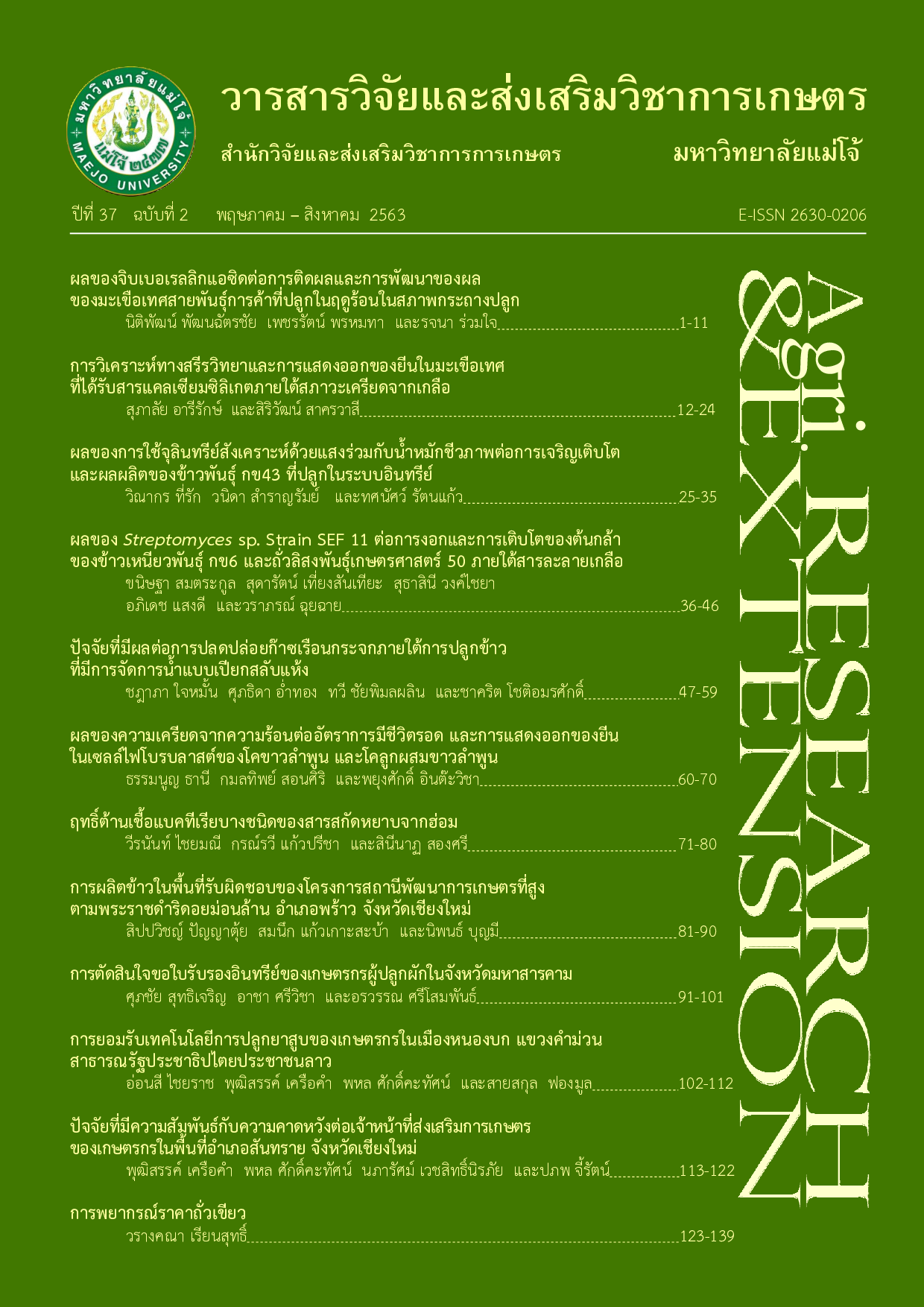การวิเคราะห์ทางสรีรวิทยาและการแสดงออกของยีนในมะเขือเทศ ที่ได้รับสารแคลเซียมซิลิเกตภายใต้สภาวะเครียดจากเกลือ
คำสำคัญ:
แคลเซียมซิลิเกต, ยีน, ทนเค็ม, มะเขือเทศบทคัดย่อ
ปัจจุบันหลายประเทศกำลังประสบปัญหา เรื่องดินเค็ม เนื่องจากความแห้งแล้งและการสะสมของเกลือทะเลในพื้นที่ทางการเกษตร ส่งผลให้พืชมีการเจริญเติบโตผิดปกติ และผลผลิตทางการเกษตรลดลง ในงานวิจัยนี้ประยุกต์ใช้ CaSiO3 กับต้นมะเขือเทศที่อยู่ในสภาวะเครียดเกลือที่ความเข้มข้น 50 mM พบว่าการเพิ่ม CaSiO3 1.25 mM มีแนวโน้มช่วยให้ต้นมะเขือเทศ มีปริมาณคลอโรฟิลล์ ปริมาณน้ำสัมพัทธ์ และน้ำหนักมากกว่าต้นที่ไม่ได้รับ CaSiO3 1.25 mM เมื่อวิเคราะห์การแสดงออกของยีน HAK5 APPR2-like gene และ SOS2 จากใบของมะเขือเทศที่อยู่ในสภาวะเครียดเกลือ ที่ความเข้มข้น 50 mM พบว่าต้นมะเขือเทศที่ได้รับ CaSiO3 1.25 mM มีการแสดงออกของยีน HAK5 มากกว่าต้นที่ไม่ได้รับ CaSiO3 1.25mM อย่างมีนัยสำคัญทางสถิติในสัปดาห์ที่ 4 และมีการแสดงออกของยีน APPR2-like gene มากกว่าต้นที่ไม่ได้รับ CaSiO3 1.25 mM อย่างมีนัยสำคัญในสัปดาห์ที่ 2 ในขณะที่ยีน SOS2 ไม่มีการแสดงออกตลอดการทดลองในต้นมะเขือเทศที่อยู่ในสภาวะเครียดเกลือทั้งต้นที่ได้รับและไม่ได้รับ CaSiO3 1.25 mM จากการวิเคราะห์พบว่าการให้ CaSiO3 1.25 mM กับต้นมะเขือเทศที่อยู่ในสภาวะเครียดเกลือที่ความเข้มข้น 50 mM สามารถช่วยให้ต้นมะเขือเทศมีผลทางสรีรวิทยาและการแสดงออกของยีนที่ตอบสนองต่อความเค็ม ได้ดีกว่าต้นที่ไม่ได้รับ CaSiO3 1.25 mM นอกจากนี้ยังช่วยให้ต้นมะเขือเทศที่อยู่ในสภาวะเครียดเกลือมีค่าดัชนี ทางสรีรวิทยาและการแสดงออกของยีนที่ตอบสนองต่อความเค็มใกล้เคียงกับต้นควบคุมมากที่สุดจนถึงสัปดาห์ที่ 4
เอกสารอ้างอิง
Aguilar, F., U.R. Charrondiere, B. Dusemund, P. Galtier, J. Gilbert, D.M. Gott, S. Grilli, R. Guertler, G.E.N. Kass, J. Koenig, C. Lambré, J.C. Larsen, J.C. Leblanc, A. Mortensen, D. Parent-Massin, I. Pratt, I.M. Rietjens, I. Stankovic, P. Tobback, T. Verguieva and R. Woutersen. 2009. Calcium silicate and silicon dioxide/silicic acid gel added for nutritional purposes to food supplements. The EFSA Journal 1132: 1-24.
Asmar, S.A., E.M. Castro, M. Pasqual, F.J. Pereira and J.D.R. Soares. 2013. Changes in leaf anatomy and photosynthesis of micropropagated banana plantlets under different silicon sources. Sci. Hortic. 161: 328-332
Belver, A., R. Olías, R. Huertas and M.P. Rodríguez-Rosales. 2012. Involvement of SlSOS2 in tomato salt tolerance. Bioengineered 3: 298-302.
Carey, A.T., K. Holt, S. Picard, R. Wilde, G.A. Tucker, C.R. Bird, W. Schuch and G.B. Seymour. 1995. Tomato exo-(1–>4)-β-D-galactanase. Isolation, changes during ripening in normal and mutant tomato fruit, and characterization of a related cDNA clone. Plant Physiol. 108: 1099-1107.
Demetriou, G., C. Neonaki, E. Navakoudis and K. Kotzabasis. 2007. Salt stress impact on the molecular structure and function of the photosynthetic apparatus-the protective role of polyamines. Biochim. Biophys. Acta, Bioenerg. 1767(4): 272-280.
Hadi, M.R. and N. Karimi. 2012. The role of calcium in plants salt tolerance. J. Plant Nutr. 3: 2037-2054.
Hasanuzzaman, M., K. Nahar and M. Fujita. 2013. Plant response to salt stress and role of exogenous protectants to mitigate salt-induced damages. pp. 25-87. In Ahmad, P., M.M. Azooz and M.N.V. Prasad (eds.) Ecophysiology and Responses of Plants under Salt Stress. New York: Springer.
Huertas, R., R. Olías, Z. Eljakaoui, F.J. Gálvez, J. Li, P.A. De Morales, A. Belver and M.P. Rodríguez-Rosales. 2012. Overexpression of SlSOS2 (SlCIPK24) confers salt tolerance to transgenic tomato. Plant Cell Environ. 35: 1467-1482.
Huertas, R., L. Rubio, O. Cagnac, M.J. Garcia-Schanchez, J. De Dios Alche, K. Venema, J.A. Fernandez, M.P. Rodriguez-Rosales. 2013. The K+/H+ antiporter LeNHX2 increases salt tolerance by improving K+ homeostasis in transgenic tomato. Plant Cell Environ. 36: 2135-2149.
Maxwell, K. and G.N. Johnson. 2000. Chlorophyll fluorescence-a practical guide. J. Exp. Bot. 51: 659-668.
Muneer, S., Y.G. Park, A. Manivannan, P. Soundararajan and B.R. Jeong. 2014. Physiological and proteomic analysis in chloroplasts of Solanum lycopersicum L. under silicon efficiency and salinity stress. Int. J. Mol. Sci. 15: 21803-21824.
Nieves-Cordones, M., A.J. Miller, F. Alema´n, V. Martı´nez and F. Rubio. 2008. A putative role for the plasma membrane potential in the control of the expression of the gene encoding the tomato high-affinity potassium transporter HAK5. Plant Mol. Biol. 68: 521-532.
Pan, Y., G. Bradley, K. Pyke, G. Ball, C. Lu, R. Fray, A. Marshall, S. Jayasuta, C. Baxter, R. Wijk, L. Boyden, R. Cade, N. Chapman, P. Fraser, C. Hodgman and G. Seymour. 2013. Network inference analysis Identifies an APRR2-like gene linked to pigment accumulation in tomato and pepper fruits. Plant Physiol. 161: 1476-1485.
Roberts, B.R. 1987. Methods for measuring water status and reducing transpirational water loss in trees. J. Arboriculture 13(2): 52-61.
Soares, J.D.R., M. Pasqual, A.G. De Araujo, E.M. De Castro, F.J. Pereira and F.T. Braga. 2012. Leaf anatomy of orchids micropropagated with different silicon concentrations. Acta Sci. Agron. 34: 413-421.
Soundararajan, P., I. Sivanesan, E.H. Jo and B.R. Jeong. 2013. Silicon promotes shoot proliferation and shoot growth of Salvia splendens under salt stress in vitro. Hort. Environ. Biotechnol. 54: 311-318.
Wang, S., P. Liu, D. Chen, L. Yin, H. Li and X. Den. 2015. Silicon enhanced salt tolerance by improving the root water uptake and decreasing the ion toxicity in cucumber. Front Plant Sci. 6(759): 1-10.
Willits, D.H. and M.M. Peet. 2001. Using chlorophyll fluorescence to model leaf photosynthesis in greenhouse pepper and tomato. Acta Hortic. 507: 311-315.
Zhou, X., Y. Shen, X. Fu and F. Wu. 2018. Application of sodium silicate enhances cucumber resistance to fusarium wilt and alters soil microbial communities. Front Plant Sci. 9(624): 1-12.
ดาวน์โหลด
เผยแพร่แล้ว
รูปแบบการอ้างอิง
ฉบับ
ประเภทบทความ
สัญญาอนุญาต
บทความนี้ได้รับการเผยแพร่ภายใต้สัญญาอนุญาต Creative Commons Attribution-NonCommercial-NoDerivatives 4.0 International (CC BY-NC-ND 4.0) ซึ่งอนุญาตให้ผู้อื่นสามารถแชร์บทความได้โดยให้เครดิตผู้เขียนและห้ามนำไปใช้เพื่อการค้าหรือดัดแปลง หากต้องการใช้งานซ้ำในลักษณะอื่น ๆ หรือการเผยแพร่ซ้ำ จำเป็นต้องได้รับอนุญาตจากวารสาร





